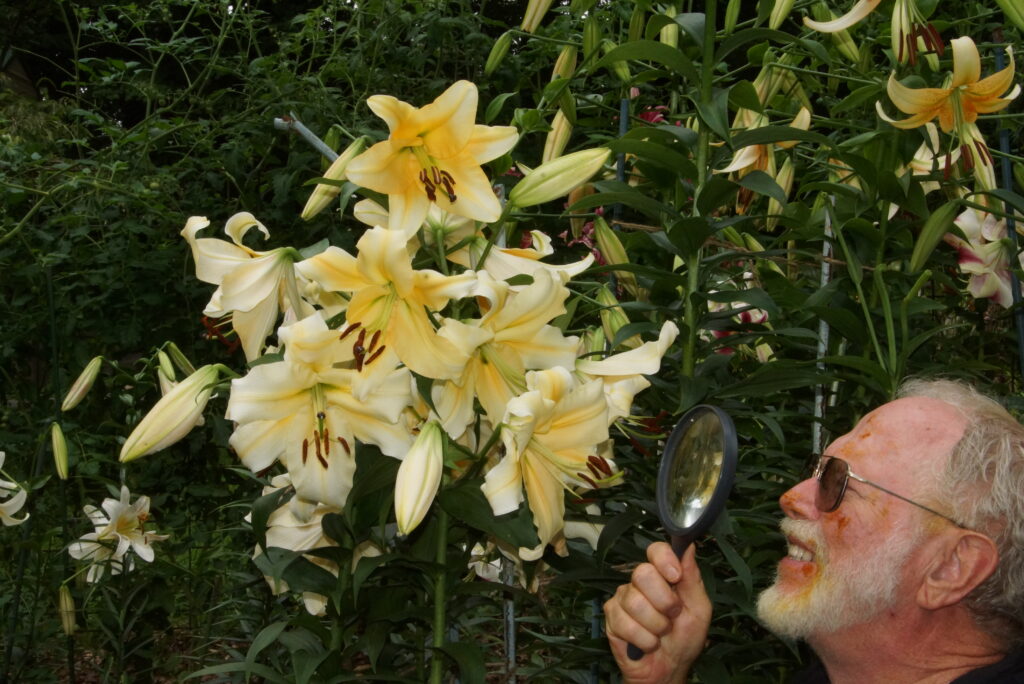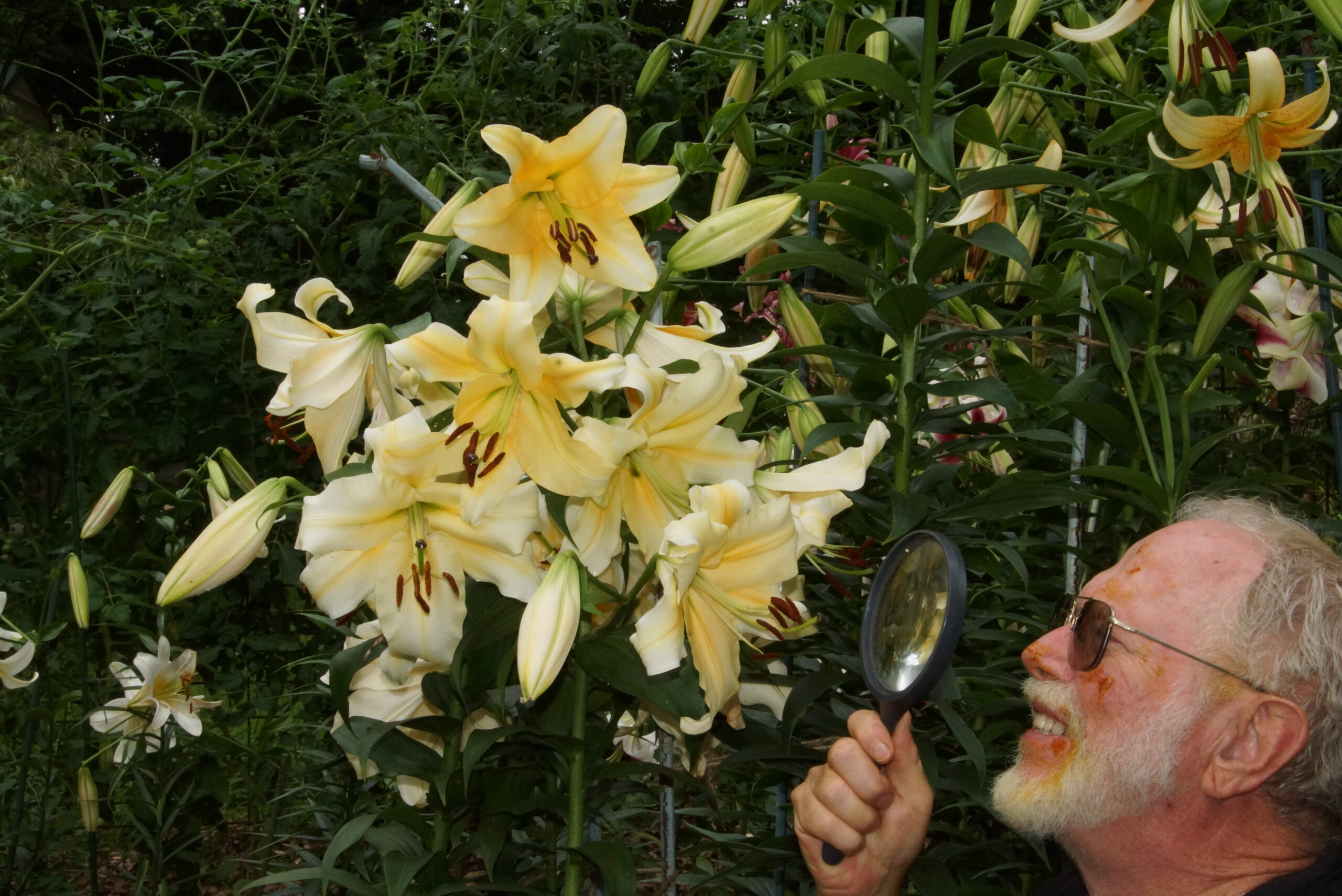
by Arthur F. Evans
Sometimes collecting , growing, and showing your lilies just isn’t enough. The day may come when your garden does not have room for one more lily, but your creative urges kick in and you say, “I want lilies that are newer than new. I want to create my own originals to suit my own tastes.” When I came to that point, a whole new world of enjoyment and fulfillment opened up in my somewhat small, untidy, country garden.
Fortunately, many openhearted and openhanded professionals and advanced amateurs helped me reach higher and steer clear of some time wasting mistakes. Here are a few things I’ve learned from some fine human beings, some living and some sadly gone, from over the garden fence and over the Internet, a synergy that spawns epiphany.
All of my hybridizing heroes would have agreed that to succeed you must focus on what you most want to accomplish, and don’t take your eyes off the prize. I’d love to grow some of everything, but I don’t have the room, time, or strength. Possum Holler is a “fur piece” from the climate where most lilies thrive. It is zone 6 at the western edge of the Ozark hill country. The sorry clay soil, what there is of it, needs a lot of help and tends to build up soil-borne diseases. Late frosts are maddeningly destructive, and this predisposes damaged plants to botrytis in our wet spring weather. In June the rain stops, and the Devil is right at home in our blazing hot, dry but humid summer. I call it Lily Hell.
My first focus was on developing lilies which would thrive in the South. Having tried some of almost everything commercially available, the survivors gave me an idea of where to start. Unfortunately, few orientals, my favorites, were survivors. The Aurelians, by contrast, are happy enough here in Lily Hell.
A visit with LeVern Freimann in 1987 convinced me that the new orienpet hybrids were the way to go. By combining oriental bloom qualities with aurelian heat and disease tolerance, I might have the best of both. LeVern had started in this direction with a foundation of ‘Tetra Black Beauty’ and ‘Tetra Journey’s End, ‘ both of which he converted using the mashed pulp of colchicum bulbs. His ‘Scarlet Delight’ came from this cross. Peter Schenk’s ‘Arabesque’ has the same breeding. I set about to build on the possibilities they brought to light.
L. speciosum is the only source of heat tolerance and virus tolerance among the Oriental species, so it is no surprise that two of its older hybrids, ‘Journey’s End’ and ‘Allegra,’ are some of the few oriental hybrids which persist here. Happily, a new, more outfacing white oriental, ‘Alma Ata,’ introduced by Johan Mak, also shows reasonable heat tolerance. Since I need these clones for breeding in a tetraploid orienpet gene pool, I have sent them to Iribov, a company in The Netherlands which specialized in tissue culture and conversion of diploid lilies to tetraploids. At current prices of about US $300 per clone they convert it to tetraploid and multiply the conversion to about 50 bulblets. I do some conversions myself with oryzalin, but it is a slow and uncertain procedure requiring many scales. If you want to convert something rare or expensive, you need fast guaranteed results.
Part II
After setting your goal, spend some serious study time deciding what available breeding material might get your program on the right track. Here, reading will help, but learning everything you can from other, more advanced, addicts is one of the most enjoyable parts. If you are lucky, this phase can last the rest of your life. N.A.L.S. is rich in experienced hybridizers who are easier to get started talking than they are to stop. Don’t be shy. Just have the tape running, and pack a spare. You probably wouldn’t be able to write fast enough .
Part III
When assembling potential breeding stock, don’t hobble yourself by getting only one bulb of each clone. Unless something is very new and expensive, get at least 3 or more of each clone and at least a dozen of a strain or a species. If you have only one bulb of something important to your plan and a gopher eats it, you waste a year or more trying to replace it and make the crucial cross. Accidents and critters happen, so prepare for the worst.
If you mature more good seed than you need, the N.A.L.S. Seed Exchange would love to share it with our members. If you would rather keep it, freeze it in small airtight containers after it is well dried. The same goes for pollens. I freeze pollens of late blooming clones to use on early blooming types the following spring. When the stored variety blooms again, I toss the old and replace it with fresh. Make sure it is well dried before freezing pollen. Two or three days in an air-conditioned room is fine for most types, a day or two longer for big tetraploid anthers. I pick anthers before they open so I’m sure they have not been contaminated with other pollens by critters. It saves more precious pollen, too.
I use the APC rule: Always Plant Chaff. You would be surprised how many chaffy, worthless looking seeds actually germinate if they get a chance. The really surprising part is that these seedlings often appear just as strong as seedings from plumper seeds with visible embryos. An article on this surprising finding was published by N.A.L.S. not long ago
Professional hybridizers have some very big advantages which speed their progress. From Ed McRae I learned that one advantage is being able to raise a Significant Seedling Population from any given cross. If you have at least 100 seedlings to choose from in a cross, you have a good idea of what that cross can produce in quality and variation. If you have only 5 seedlings from a cross, did you flower the best ones possible from your cross? Maybe, but probably not. Don’t waste 3 or 4 years repeating a cross because you didn’t flower enough seedlings to get the best out of a cross the first time.
Part IV
Cull your seedlings ruthlessly! Shame on anyone who saves and breeds with a seedling which has a gorgeous bloom, but has low vigor and low tolerance to the common lily diseases. It will help your project and your reputation immeasurably if you resist the temptation to breed with an attractive seedling in its first bloom season. Let it get full-size and demonstrate some admirable traits besides individual bloom quality before you devote the rest of your garden to its seedlings. Too often a flashy newcomer declines in year 2, 3, and 4. You can cull faster by not spraying your seedlings. Mom and the aphids will show you pretty quickly which ones are prone to late frost damage, botrytis, fusarium, and virus.
Sometimes we don’t have enough choices in healthy, vigorous breeders. I have used Asano’s 82-111 (Auratum x henryi) which was potentially valuable as a bridging hybrid in the orienpet group, but it is notoriously dominant in passing on virus susceptibility to most of its seedlings. I tried to use it with only very virus tolerant pod parents such as ‘Journey’s End’ and persistent seedlings from my ‘Tetra Black Beauty’ hybrids. Still, most of the seedlings showed virus symptoms within 3 years. No matter how pretty the bloom is, if it starts showing the blotchy, streaky, pale foliage typical of virus infection, the seedling is history.
Part V
If you think you have a winner, share bulbs with far flung friends who will tell you the truth about how the seedling performs for them under different conditions. We have a saying here in the South: “Every mother crow thinks her little ones are the blackest.” I do too, so I send seedlings to friends on both coasts, as well as the upper Midwest and Canada. Happily, the seedlings often do better closer to Lily Heaven (the flanks of Mt. Hood) than they do here in the Devil’s Kitchen. Still, I’m looking for seedlings which thrive in the land of gumbo and grits as well as they do inthe land of lutefisk and latté.
I have yet to solve the problem of how to get a proven winner seedling from the test garden to the mass market. If you want to compete in the mass garden market you need a commercial grower and a wholesaler/retailer for promotion and distribution. Usually, the amateur hybridizer ends up trying to sell his seedling to a large bulb company for very little money in hope that the little darling will brighten the gardens of countless thousands. Usually, it doesn’t. We often hear that there isn’t much profit in garden-type lilies, which is the reason most large companies aren’t interested in what we do. They would rather sell us their surplus forcing-type lilies as appropriate for gardens all across North America. We keep falling for it and blaming ourselves when they fail to perform well. What’s wrong with this picture?
North American gardeners have discovered lilies, and they will pay a good price for quality and diversity. They are becoming more sophisticated, however, wanting a dependable hardy perennial instead of an expensive annual. There are a lot of excellent new garden lilies in the backyards of amateur hybridizers. Who will step up to this opportunity with the know how and financial backing to bring North American gardeners really good garden-adapted lilies in the mass market venues where they already buy billions of dollars’ worth of other plants and supplies?
Every June and July morning when the first bloom seedlings are opening, I bounce out of bed like I was on springs. What a thrill it is to see the new faces and know that they may make a real difference in the enjoyment of lilies for many fellow gardeners whose climates were too hostile for lilies of the past. If I could make a wish for the new year, it would be that all of you could enjoy the same feeling of fulfillment by making your own crosses and flowering your own seedlings.
©Copyright 2002 by Arthur F. Evans
Arthur Evans
PO Box 186
Gravette Arkansas 72736 USA
